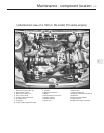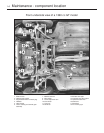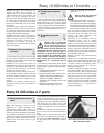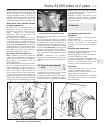
2 Check the pipes and connections for
evidence of leaks, severe corrosion, or
damage. Make sure that all brackets and
rubber mountings are in good condition, and
tight; if any of the mountings are to be
renewed, ensure that the replacements are of
the correct type. Leakage at any of the joints
or in other parts of the system will usually
show up as a black sooty stain in the vicinity
of the leak.
3 At the same time, inspect the underside of
the body for holes, corrosion, open seams,
etc. which may allow exhaust gases to enter
the passenger compartment. Seal all body
openings with silicone or body putty.
4 Rattles and other noises can often be
traced to the exhaust system, especially the
rubber mountings. Try to move the system,
silencer(s) and catalytic converter. If any
components can touch the body or
suspension parts, secure the exhaust system
with new mountings.
18 Bodywork, paint and exterior
trim check
1
1 The best time to carry out this check is after
the car has been washed so that any surface
blemish or scratch will be clearly evident and
not hidden by a film of dirt.
2 Starting at one front corner check the
paintwork all around the car, looking for minor
scratches or more serious dents. Check all
the trim and make sure that it is securely
attached over its entire length.
3 Check the security of all door locks, door
mirrors, badges, bumpers, radiator grille and
wheel trim. Anything found loose, or in need
of further attention should be done with
reference to the relevant Chapters of this
manual.
4 Rectify any problems noticed with the
paintwork or body panels as described in
Chapter 11.
19 Headlight beam alignment
check
1
Accurate adjustment of the headlight beam
is only possible using optical beam-setting
setting equipment, and this work should
therefore be carried out by a Peugeot dealer
or service station with the necessary facilities.
Basic adjustments can be carried out in an
emergency, and further details are given in
Chapter 12.
20 Air conditioning system
check
1
Warning: The air conditioning
system is under high pressure.
Do not loosen any fittings or
remove any components until
after the system has been discharged. Air
conditioning refrigerant must be properly
discharged into an approved type of
container, at a dealer service department
or an automotive air conditioning repair
facility capable of handling the refrigerant
safely. Always wear eye protection when
disconnecting air conditioning system
fittings.
1 The following maintenance checks should
be performed on a regular basis, to ensure
that the system continues to operate at peak
efficiency:
a) Check the auxiliary drivebelt. If it’s worn
or deteriorated, renew it.
b) Check the system hoses. Look for cracks,
bubbles, hard spots and deterioration.
Inspect the hoses and all fittings for oil
bubbles and seepage. If there’s any
evidence of wear, damage or leaks, renew
the hose(s).
c) Inspect the condenser fins for leaves,
insects and other debris. Use a “fin
comb” or compressed air to clean the
condenser.
Warning: Wear eye protection
when using compressed air!
d) Check that the drain tube from the front
of the evaporator is clear - note that it is
normal to have clear fluid (water) dripping
from this while the system is in operation,
to the extent that quite a large puddle can
be left under the vehicle when it is parked.
2 It’s a good idea to operate the system for
about 30 minutes at least once a month,
particularly during the winter. Long term
non-use can cause hardening, and
subsequent failure, of the seals.
3 Because of the complexity of the air
conditioning system and the special
equipment necessary to service it, in-depth
repairs are not included in this manual, apart
from those procedures covered in Chapter 3.
4 The most common cause of poor cooling is
simply a low system refrigerant charge. If a
noticeable drop in cool air output occurs, the
following quick check will help you determine
if the refrigerant level is low.
5 Warm the engine up to normal operating
temperature.
6 Place the air conditioning temperature
selector at the coldest setting, and put the
blower at the highest setting. Open the doors
- to make sure the air conditioning system
doesn’t cycle off as soon as it cools the
passenger compartment.
7 With the compressor engaged - the clutch
will make an audible click, and the centre of
the clutch will rotate - feel the inlet and outlet
pipes at the compressor. One side should be
cold, and one hot. If there’s no perceptible
difference between the two pipes, there’s
something wrong with the compressor or the
system. It might be a low charge - it might be
something else. Take the vehicle to a dealer
service department or an automotive air
conditioning specialist.
21 Manual transmission oil level
check
2
Note: The following procedure is only
applicable to models produced after
approximately October 1986. There is no
provision on the transmission for fluid level
checking on earlier transmissions (see Chapter
7A). Suitable square-section wrench may be
required to undo the transmission filler/level
plug on some models. These wrenches can be
obtained from most motor factors or your
Peugeot dealer.
1 Park the car on a level surface. The oil level
must be checked before the car is driven, or
at least 5 minutes after the engine has been
switched off. If the oil is checked immediately
after driving the car, some of the oil will
remain distributed around the transmission
components, resulting in an inaccurate level
reading.
2 Prise out the retaining clips and remove the
access cover from the left-hand wheelarch
liner.
3 Wipe clean the area around the filler/level
plug, which is situated on the left-hand end of
the transmission (see illustration). Unscrew
the plug and clean it; discard the sealing
washer.
Every 12 000 miles or 12 months 1•13
1
21.3 Using a square section wrench to
unscrew the transmission filler/level plug
(MA transmission shown)
Every 24 000 miles or 2 years


















